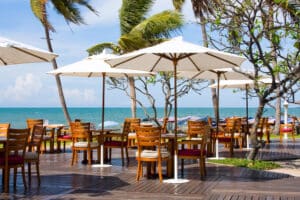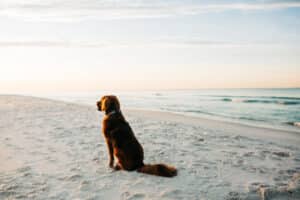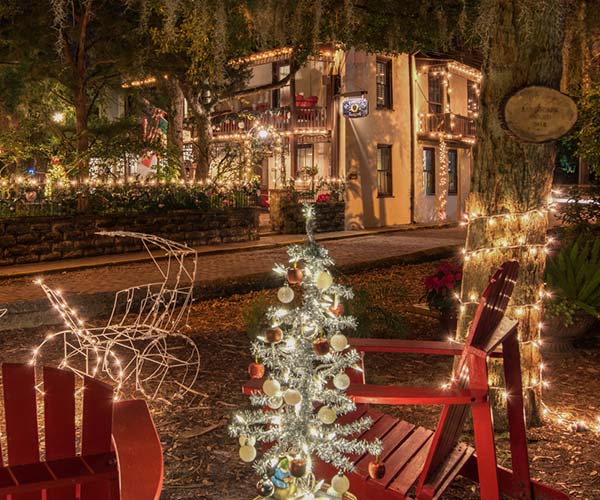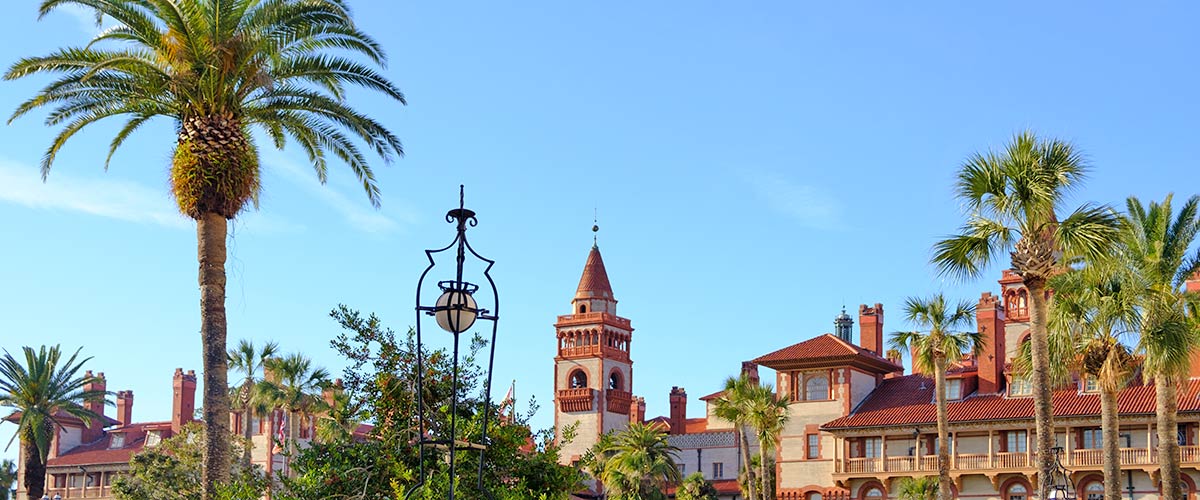
St. Augustine, Florida
The St. Francis Inn is unique in location — right in the heart of the oldest part of St. Augustine, a designated Historic District. The narrow brick paved streets offer scores of charming restaurants, museums, galleries, antiques, historic sites, a variety of shopping experiences and lovely private residences… all easily within walking distance of the Inn. St. Augustine is a rich cultural center, with special events held in the old city throughout the year. A stroll through the oldest city’s historic district, along the narrow ancient streets around the Inn, is not to be missed. Let us tell you more.
St. Francis Inn is ideally located on St. George Street which runs through the center of the Old City, and dates back to the earliest days in the City’s history of European settlement. As you walk toward the Old City Gates at the north end of St. George Street, you’ll discover 11 blocks restricted to pedestrian-only traffic. You can easily stroll along the promenade, lined with palm trees and benches, day or night. The pedestrian area is lined by original, restored, and reconstructed 18th-century homes which are now historic landmarks, museums, a multitude of unique shops, snack spots, and excellent restaurants. Explore other nearby streets and tiny side alleys too and discover al fresco dining, arbors covered with flowering jasmine, small artsy shops, fun pubs, and unexpected treasures.
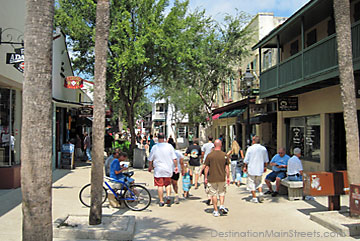
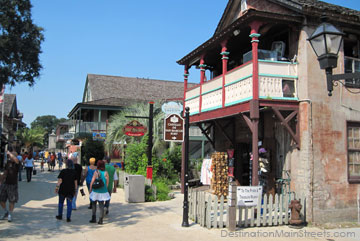
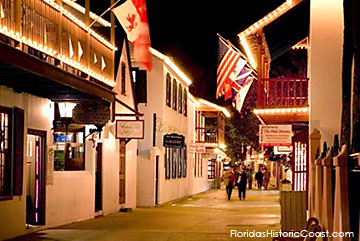
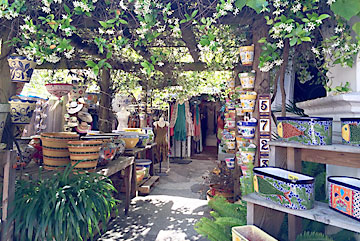

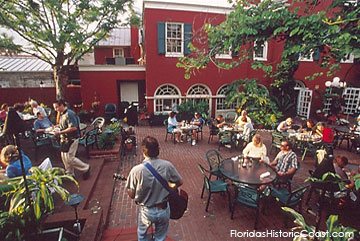
St. Augustine was founded forty-two years before the English colony at Jamestown, Virginia, and fifty-five years before the Pilgrims landed on Plymouth Rock in Massachusetts – making it the oldest permanent European settlement on the North American continent.
St. Augustine’s Historic District is a National Historic Landmark, encompassing 144 blocks along the Matanzas River Bayfront, much of which was once within Spanish walls for protection. The size and scope of the city’s Historic District is amazing. Laid out according to the Spanish town plan in the late 16th century, the narrow streets and central plaza – “The Plaza de la Constitucion” – are vestiges of St. Augustine’s early heritage.
Many colonial buildings in the District date from 1703 to 1821. The boundaries of the Historic District are Orange Street (on the North), San Marcos Street and the Matanzas River Bayfront (on the East), St. Francis Street (on the South) and Cordova Street (on the West). Explore these narrow brick-lined streets and see many old structures which were built of the locally quarried coquina stone, many which are more than 200 years old.
A massive community restoration project was initiated during the 1970s and resulted in bringing the cultural history of the city back to life. Visit Castillo de San Marcos (1695), the nation’s oldest and only remaining 17th century stone fort, a National Historic Monument which you can tour inside and out. There are guided tours around all sorts of themes – culinary, art, historical, haunted, nature, tastings, chocolate, pirates, cemeteries, ecological, sailing, and more.
Horse-drawn carriage rides around the Old City provide a unique way to absorb the stories of yesteryear, evening ghost tours delight you with their tales, step-on-and-off trolleys bring you to landmarks and special locations, and harbor cruises and sails provide other perspectives of this beautiful ancient city. Our Innkeepers can provide more specific information during your stay.
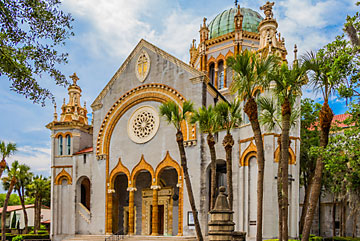
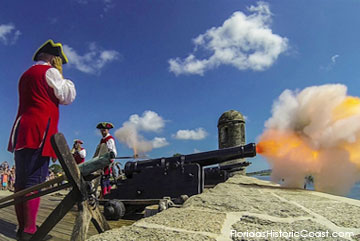
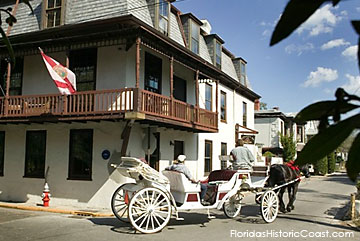
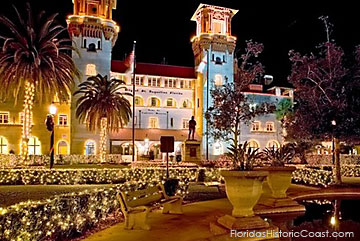
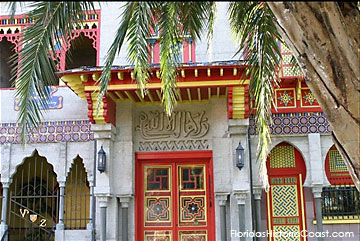
As the oldest permanent city in what is now continental United States, St. Augustine offers an astounding variety of things to do and see. From Spanish colony to British rule to statehood, St. Augustine’s long history and varied cultural influences are evident in its streets and buildings. Within the Old City and just on its outskirts are many sites and happenings for visitors:
- Bridge of Lions
- Castillo de San Marcos National Monument
- Cathedral Basilica of St. Augustine
- Colonial Quarter St. Augustine
- First Friday Art Walk
- Flagler College
- The Government House Museum
- Lightner Museum
- Lincolnville Historic District
- Memorial Presbyterian Church
- Nights of Lights
- Old City Gates
- Oldest House & Museum (Gonzalez-Alvarez House)
- Oldest Wooden School House
- Pena-Peck House
- The Plaza de la Constitucion
- Potter’s Wax Museum
- San Sebastian Winery
- Spanish Military Museum
- St. Augustine Historical Society
- St. Augustine Arts Center
- St. Augustine Distillery
- St. Augustine National Cemetery
- St. Augustine Pirate & Treasure Museum
- St. Photios Orthodox National Shrine
- Trinity Episcopal Church
- Villa Zorayda
- Ximenez-Fatio House Museum
The city’s calendar is packed year-round with festivals, religious pageants, historic re-enactments, ethnic heritage events, and celebrations of history and culture. Seasonal events such as Nights of Lights, which bathes the Old City with sparkling white holiday lights, Easter celebrations, spectacular Fourth of July fireworks over the bayfront, and New Years parties are great fun. Enjoy arts and craft fairs, seafood festivals, colonial celebrations, concerts, music festivals, food events, native American ceremonies, historic weapons demonstrations, and torchlight parades.
For an up-to-date calendar of events, including Festivals, Living History, Visual Arts, Performing Arts, Literary Arts, Cultural Events, Classes, and much more, visit Historic Coast Culture and Old City Calendar.
Reminder, guests of the Inn receive a 50% discount on admission to the nearby Oldest House – one of St. Augustine’s finest treasures of local history, just a block down St. Francis Street from the Inn. Our guests also receive complimentary admission to the St. Augustine Lighthouse and Museum. At both of these historic landmarks, our guests also receive discounts on purchases in the gift shops. See our Guest Amenities for details on the many perks, activities and benefits that add up to a superb value for our guests!
Outside the Old City area are other many historic sites, attractions, events, and places to visit, such as
- Alligator Farm Zoological Park
- Anastasia State Park
- Castle Warden & Ripley’s Believe It or Not
- Florida Agricultural Museum
- Fountain of Youth Archaeological Park
- Fort Matanzas National Monument
- Fort Mose Historic State Park
- Guana Tolomato Matanzas (GTM) National Estuarine Reserve
- Limelight Theatre
- Marineland Dolphin Adventure
- Mission Nombre de Dios
- Old Jail Museum
- Outlet Shopping in St. Augustine
- PGA Players Championship at TPC Sawgrass
- San Marco District
- St. Augustine Amphitheater
- St. Augustine Lighthouse & Museum
- St. Augustine Visitor Information Center
- Vilano Town Center
- Washington Oaks State Gardens
- World Golf Hall of Fame & IMAX Theater
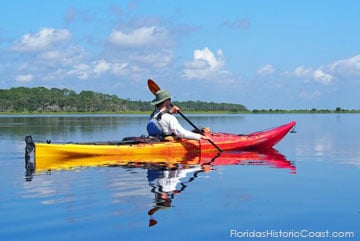
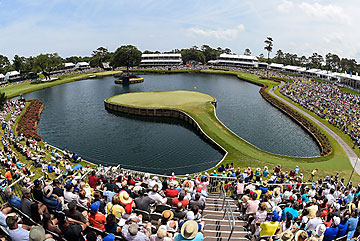
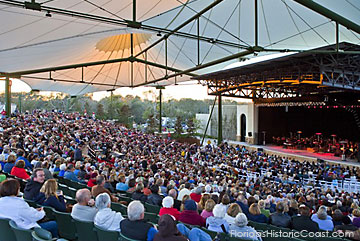
Anastasia Island
This large barrier island is just across the Bridge of Lions over the Matanzas River from the historic Old City of St. Augustine. Its eastern shore is home to 1600-acre Anastasia State Park (with 4 miles of pristine beach) plus 14 miles of wide sandy public beach, gentle waves, a maritime hammock, and dunes of sea oats waving in the breeze. The beach is perfect for sunning, beachcombing, biking, and sand castle building. Watersports abound, including swimming, fishing, surfing, kayaking, sailing, windsurfing, boating, paddleboards, and more. Rentals are available on the island. Watch shorebirds galore, hunt for seashells, and keep your eyes posted for passing schools of bottlenose dolphins and migrating right whales. Anastasia is also home to the 165-ft. black-and-white striped St. Augustine Lighthouse & Museum, the public Beach Fishing Pier with Volleyball Courts and Wednesday Farmer’s Market. Also nearby are Fort Matanzas National Monument, Fiesta Falls miniature golf, the St. Augustine Alligator Farm and Zoological Park, Marsh Creek Country Club, many interesting shops, restaurants, and special events. St. Augustine Amphitheater is a state-of-the-art performing arts venue for audiences of 4000+. It plays host to the Saturday morning Old City Farmer’s Market, plus a year-round schedule of concerts, fairs, festivals and other cultural events. From A Street and Ocean Trace Road you can drive and park on the beach (fee required). There are 2 public tennis courts and a dog park at Ron Parker Park on Anastasia Island.
If all this still leaves you looking for things to do, we also have boating, fishing, golf, tennis, watersports, horseback riding, helicopter tours, state gardens, trolley tours, walking tours, carriage tours, trail hikes, sailing tours, scenic cruises, bird watching, nature preserves, biplane rides, eco-tours, mini golf, wine and spirit tastings, festivals, re-enactments, weapons demonstrations, parades, farmers markets, flea markets, ballet, fireworks, concerts, lectures, cultural events, and more!
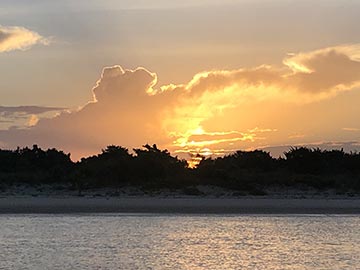
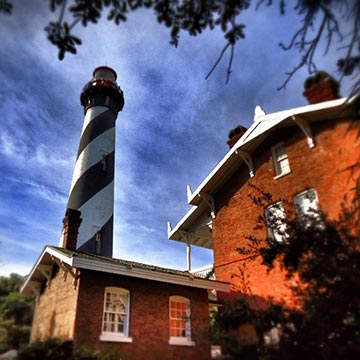
Alligator Farm Zoological Park
A specialized accredited zoo and major attraction striving to instill appreciation and understanding of crocodilians, exotic birds, playful primates and other wildlife. See every recognized living species of crocodilian, lemurs, pythons, native Florida reptiles, exotic birds and mammals, fossil discoveries, and more. Daily wildlife shows on reptiles, snakes, rainforest, and more. Thrilling Crocodile Crossing zip-line across 7 acres. The Bird Rookery is home to wild and unconfined herons, ibis, egrets, spoonbills and wood storks, able to be viewed intimately from the wooden walkway during their nesting season.
Open every day 9am-5pm, ’til 6pm Memorial Day through Labor Day.
Located at 999 Anastasia Blvd. St. Augustine, FL
Anastasia State Park
St. Augustine Beach is one of the world’s most beautiful, and this state park includes 4 miles of pristine beachfront plus 1600 acres of rich ecosystem and abundant wildlife. Self-guided nature trail, coquina stone quarry, swimming, surfing, beachcombing, fishing, bird watching, shelling. Picnic facilities and grills, playgrounds. Rentals of bicycles, paddleboards, kayaks, sail boats and canoes. Grill area with wi-fi, small gift shop and grill.
Open every day 8am to sundown.
Located at 300 Anastasia Park Road,
St. Augustine Beach, FL.
Bridge of Lions
The Bridge of Lions spans Matanzas Bay, which is part of the Intracoastal Waterway, connecting the Old City of St. Augustine with Anastasia Island, and is designated SR A1A. It is a double-leaf “bascule” or drawbridge, providing clearance for boat traffic, with a span of 1,574-feet. The bridge is named for the stately pair of stone lions at the base of the bridge on the west end.
The Carrara marble Medici lion statues, named “Firm” and “Faithful,” were created as copies of statues found in the Loggia die Lanzi in Florence, Italy. They were a gift from Dr. Andrew Anderson (1839-1924), a friend of Henry Flagler, who unfortunately did not live to see them installed, as the bridge construction took place from 1925-1927. The lion statues were commissioned by Dr. Anderson to the Romanelli Studios in Florence, Italy, which a decade earlier produced two smaller lions which he displayed on the front steps of his home, Markland House at 102 King Street, now part of Flagler College.
The Bridge of Lions replaced a ferry boat and a wooden toll bridge built in 1895 which accommodated a trolley and had a movable opening for marine traffic. The bridge had been renovated in 1904, but by 1920 a bond issue was organized for a new bridge. The construction came during the height of the Florida land boom of the 1920s, which its extravagance reflected. It was designed to transport cars, but also to be a work of art and a landmark for the city.
In 1999 the Florida DOT declared the Bridge of Lions to be “structurally deficient and functionally obsolete.” Heated debates grew on what to do with the structure, resulting with a restoration plan which cost about $80 million, required the construction of a temporary bridge, and took five years to complete. The “new” bridge was reconstructed to look like the original. The marble lions, in storage and refurbishment for 6 years during the bridge renovation, were returned to their original location in 2011. The Bridge of Lions allows two lanes of vehicular traffic, with a sidewalk on each side. The Bridge is listed on the National Register of Historic Places.
World Golf Hall of Fame & IMAX Theater
Dedicated to preserving and honoring the history of golf and legacies of those who made the sport great, the World Golf Hall of Fame & Museum features permanent exhibits, Shell’s Wonderful World of Golf Theater, the Hall of Fame gallery, a golf simulator with some of the world’s elite courses, plus special shows and events. Admission includes museum entry for 2 days, one round on the 18-hole putting course, and one shot at the challenge hole. Open every day except Christmas and Thanksgiving.
The IMAX at the World Golf Hall of Fame is North Florida’s largest screen, at five stories high! Experience the crystal clear images and powerful digital sound while enjoying entertaining and educational documentaries as well as blockbuster movies. Located at One World Golf Place, St. Augustine, FL 32092
Located at 1 World Golf Place, St. Augustine, FL 32092
Castillo de San Marcos National Monument
St. Augustine’s fort is a great tourist attraction and exceptional historic site, intriguing visitors of all ages. As the oldest masonry fortress in the continental US and only surviving 17th century military construction in North America, the Castillo de San Marcos (“Castle of St. Marks”) is located on 21 acres on Matanzas Bay in the city of St. Augustine. After founding St. Augustine in 1565, the Spanish settlers found their most significant threat was from the British, attempting to establish strongholds in Florida, Carolina and Georgia Colonies. Sir Francis Drake led a successful raid in 1568, sacking, looting and burning the settlement in St. Augustine, including the wooden fort. Nine forts, all constructed of wood, were built for protection of St. Augustine in its early years.
The building of the Castillo de San Marcos, a masonry fort, took place from 1672-1695, partly in reaction to the founding of Charleston by the British. The Castillo’s massive coquina limestone walls, quarried across the bay on Anastasia Island, still stand as evidence of the clashes between cultures during the colonial period of our nation’s history. Its survival is legacy to the craftsmanship of the engineers and laborers who constructed it.
Through a 1763 peace treaty to end the French and Indian War, the British finally gained what they failed to take by force, as Florida was ceded to Great Britain as part of settling the French & Indian War. The fort, renamed Fort St. Marks, protected British St. Augustine for twenty years. Spain sided with the 13 colonies during the Revolutionary War and secured the return of Florida after England’s defeat. In the early 1800s, Spain struggled to retain its western hemisphere colonies. The expanding United States considered Florida vital to its interests. In 1821, a treaty peacefully turned East and West Florida over from Spain to the United States as a territorial possession. Florida was accepted as a state in 1845. The Castillo de San Marcos was also the stage for confrontations during the War of 1812, the Patriot Revolt, the Second Seminole War, and the Civil War (as US Fort Marion). It was used as a prison for American Indians during the late 1800s and played a minor role in the Spanish-American war, as a hold for deserters. It was abandoned by the U.S. Army in 1900 and declared a National Monument in 1924.
You can explore the fortress with a self-guided tour, join an interpretive talk with a park ranger, watch the 20-minute video, view weapons demonstrations, cannon firings, and re-enactors presentations, take in a special event on the grounds, and picnic on the bayfront green surrounding the fort. The Castillo de San Marcos is open to visitors every day except Thanksgiving and Christmas days. An adult entry fee is charged, and is valid for 7 days, with certain passes accepted for free admission. Parking is available in the lot at the fort ($1.50 per hour), where passengers can also be dropped off and picked up, and at the city parking garage one block away. The average visitor spends between one and two hours touring the Castillo de San Marcos National Monument, often returning for more than one visit. The Castillo is on the St. Augustine Bayfront, north of the Bridge of Lions.
Address: 1 S Castillo Dr, St Augustine, FL.
Castle Warden & Ripley’s Believe It or Not
Set in a historic castle, Ripley’s Odditorium is the place to find shrunken heads, matchstick and clothespin models, and the largest operational ferris wheel made from an erector set. There are 19 themed galleries on 3 floors, with over 300 exhibits and artifacts of the odd and unusual from around the world. Ripley’s is housed in historic Castle Warden, built in 1887 as the winter home of a business partner of Henry Flagler and John D. Rockefeller named William G. Warden. It is a huge residence, built in the unique Moorish Revival architectural style. It is the site of the first Ripley’s Believe It or Not to open in the US. Gift Shop, Red Train Tour Headquarters, “Ghost Train” tours.
Open every day.
Located at 19 San Marco Avenue, St. Augustine, FL.
Colonial Quarter
Centuries of St. Augustine history are presented at the Colonial Quarter 2-acre attraction, in the heart of the historic district. Guided historical adventure tours and self-guided exploration take you through St. Augustine’s past, encompassing the 16th century Spanish first city, the 17th century Spanish fortified town, the 18th century Spanish garrison town, and the 18th century British colony. Learn about the melting pot of cultures, from Native Americans and Minorcans to Spanish, British, and African-Americans. Climb the 17th century 35-foot tall watchtower replica for a stunning view of the bayfront and the nearby Castillo de San Marcos. Stroll the Flags Over St. Augustine boardwalk. See a 16th century handcrafted ship building project. Get hands-on with archaeological investigations. The sights, sounds, and smells of St. Augustine’s history await you. The Colonial Quarter has two restaurants on-site, a casual pub and a candlelit 18th century style taverna.
Open 7 days a week, 10am-6pm at 33 St. George Street, St. Augustine, FL.
First Friday Art Walk
The Art Galleries of St. Augustine (AGOSA) present the award-winning First Friday Art Walk to feature the fine work of gifted artists of the local area and beyond. From 5-9pm, galleries throughout the city celebrate on the First Friday of every month, offering new exhibits and receptions. Many offer complimentary beverages and food, and often live music. Dozens of art galleries are within walking distance of each other and some are just a short drive away, so it is easy to do a self-guided tour. Free Art Walk trains and trolleys run on a continuous 20-30 minute loop (except Dec & Jan) throughout downtown during this event, and you can start your tour at any gallery. See the fine arts, photography, and and crafts of many talented local artists, as well as work by national and international artists. Paintings, sculpture, pottery, art glass, woodworks, jewelry, stained glass, fiber art, tiles, mosaics, folk art, drawings, prints and more treasures are featured. Many artists are on hand to meet and greet and show you their work. The First Friday Art Walk is a wonderful social event for locals and visitors to St. Augustine.
Flagler College, St. Augustine
Flagler College is a small, private, 4-year residential college offering nationally renowned and accredited programs in selected liberal, business, and pre-professional studies. The College is coeducational, with an enrollment of approximately 2,500 students.
Founded in 1968, the College was established as a memorial to Henry M. Flagler, industrialist, oil magnate, land developer, and railroad pioneer. Flagler was a co-founder of Standard Oil and the single most pivotal figure in Florida’s development. The centerpiece of the campus is the former Hotel Ponce de Leon, the first of a series of grand resorts built in the late 1800s by Mr. Flagler, and a National Historic Landmark. The majestic landmark, with its stunning Spanish architecture, forms an intricate complex of buildings representing a melange of historical styles. The distinctive architecture is complemented by beautiful grounds and an impressive interior, which includes ornate hand-carved wood, panels of imported marble, elaborate murals, and Tiffany stained glass windows. The campus consists of several other historic structures, a library, a student center, an auditorium, a gymnasium, an art museum, a laboratory, a radio station and residence halls.
The Flagler College campus is located in the heart of the nation’s oldest city. The ideal climate, historic landmarks, numerous attractions, magnificent beaches, and Old World ambiance of St. Augustine provide an inviting campus environment for an institution of higher learning. The college is pledged to the preservation and use of its historic and architecturally unique campus structures. Tours of its historic buildings are offered to the public. Lectures, special events, art exhibits, and theatre productions are also presented for the community and visitors to enjoy.
The college is located at 74 King Street, St. Augustine, FL.
Florida Agricultural Museum
Florida’s rural past is revealed at this family attraction, just a short drive from St. Augustine. Visit five restored farming buildings and a 1890s pioneer homestead, take a guided tractor-pulled wagon ride and walking farm tours, see wildflowers, learn about farming history, see rare heritage livestock and other farm animals, and explore the turn-of-the-century drygoods store. Glimpse everyday Florida farm life from long ago. Pack a picnic lunch and enjoy at the tables at the barn. The museum offers guided horseback riding on trails across fields, through the woods, and by a lake. Horseback riding lessons, English and Western, are available, and there are summer riding camps.
Located at 7900 Old Kings Rd. N., Palm Coast, FL.
Fort Matanzas National Monument
As the early Spanish settlers in St. Augustine attempted to protect their city from the British colonists in Georgia and Carolina, they recognized the vulnerability of the Matanzas River Inlet from the south. An early wooden watchtower was constructed in 1569 on an island at the southern end of Matanzas Inlet, just 4 years after the Spanish arrived, and at least twice protected the settlement from attacks by the British and French pirates. An unsuccessful attack of the city by the British prompted the Spanish Governor to order a stronger stone tower to guard the southern approach, about 15 miles south of the city. Work began on Fort Matanzas in 1740, as Fort Mose was built to the north of the city. Fort Matanzas’ marsh location necessitated long piles to be driven into the wet ground to support the tall stone walls. Locally quarried coquina stone was the only available masonry material, like that used for Castillo de San Marcos. British and Indian allies repeatedly attempted to halt the construction, unsuccessfully. Fort Matanzas was completed in only 2 years, measuring 50 feet on each side with a 30-foot tower. It mounted five cannons. Its only battle took place when it was barely completed, when Georgia colonial governor James Oglethorpe and the British arrived off Matanzas Inlet with 12 ships, in 1742. Small boats were sent into the inlet as scouts, and they were driven away from a single cannon shot from the fort – the only hostile shot ever fired from Fort Matanzas!
Today, the restored fort is the centerpiece of a scenic national park, with entrance located about 15 miles south of the historic Old City. Tours of this National Monument are free and include an hourly ferry ride across the Intracoastal to the fort, which is on Rattlesnake Island. Visitors can explore the fort, view exhibits, hear talks by the ranger, boat captain and re-enactors, watch the 8-minute video, walk the 1/2 mile boardwalk nature trail from the Visitor Center, and enjoy the variety of ecosystems and natural beauty around the dock and the fort. Special events include cannon and musket firing demonstrations, torchlight tours, nature programs and bird walks.
Fort Matanzas National Monument is open to the public from 9:00am to 5:3pm every day of the year except Thanksgiving Day and Christmas Day. Boarding Passes are required to ride the ferry, which carries 36 passengers on a first-come first-serve basis. The free passes are issued at the visitor center, and the ferry departs on the half-hour. Note, the fort and ferry are closed during thunderstorms. Fort Matanzas National Monument is located about 15 miles south of the historic district of St. Augustine, Florida, on Anastasia Island. The physical address is 8635 A1A South, St. Augustine, FL 32080.
Fort Mose Historic State Park
The historic site of Fort Mose, established in 1738 by the Spanish as the northernmost point of defense of St. Augustine, is a landmark in American history. About 100 escaped African slaves, who had been serving colonists in the British settlements to the north, were given sanctuary by the Spanish and lived in St. Augustine during a time when the Spanish were trying to reinforce defenses against the British. With great tension between Spain and England, the Spanish authorities in St. Augustine envisioned a strong settlement of free blacks as a major defense for the city, and joined them in building a strong fort of logs and earth two miles north of the City Gates and Cubo Line.
Around Fort Mose, the free Africans cleared fields and built permanent homes of their own. Just one year after the fort was constructed, during a British attack by General James Oglethorpe, the Spanish evacuated the Fort Mose inhabitants into the city and the English overran Fort Mose with a force of 137 men. The Spanish launched a surprise pre-dawn attack on the fort, in a bloody battle with men of the free black militia joining the Spanish troops. The fort itself was destroyed as the Spanish-led forces defeated the British. A second Fort Mose was completed in 1752 just northeast of the original fort’s site, and free Africans lived there in peace until 1763. That year Florida was surrendered to Great Britain as part of the treaty ending the French and Indian War, and the inhabitants of Fort Mose were evacuated. Many were resettled in Cuba. The sites of the two forts became overtaken by marsh and nearly forgotten for centuries. Archaeologists eventually identified the evidence of the forts when a landowner, Jack Williams, set out to prove Fort Mose had been on his property.
Today coastal marshes cover what were once the cultivated fields of Fort Mose inhabitants, and the site of the fort is marked with trees. No remains of the earth and wooden structures remain. A boardwalk provides great opportunities for viewing the site of the original settlement, marshes, birds, and wildlife, spanning over 40 waterfront acres. Birding enthusiasts will enjoy opportunities to see species such as Bald Eagle, Great Blue Heron, and White Ibis. Interactive exhibits at the Museum Visitor Center tell the stories of first legally sanctioned free African settlement in what would become the USA, and of the two forts. Artifacts discovered by archaeologists are displayed. The park is located just north of where U.S. Hwy 1 and San Marcos Avenue merge, three miles north of the Castillo de San Marcos, just off US 1. The grounds are open daily and the Museum is open daily except Tues and Wed, with a small admission fee. Address: 15 Fort Mose Trail, St. Augustine, FL
Guana Tolomato Matanzas National Estuarine Reserve
This state preserve protects 73,352 shoreline acres which provide habitat for a wide variety of plants, birds, mammals, reptiles, amphibians, fish and other wildlife. Visit for hiking, biking, horseback riding (allowed weekdays), fishing, kayaking, canoeing, bird-watching, picnicking, sunbathing and more. Ten miles of nature trails and old roads through the hammock, coquina sand beach, high dunes, boat ramps. Environmental Education Center with natural and cultural history exhibits, aquariums, theatre, auditorium, nature store, and events. Join guided walks, lectures, and other activities.
Open daily 8am to sunset.
505 Guana River Road, Ponte Vedra Beach, FL.
Lightner Museum
The Lightner Museum is one of the finest collections of 19th century fine and decorative arts in the country, and is housed in the former Alcazar Hotel, built in 1888 by Henry Flagler. The Museum opened in 1948 with the collections of “Gilded Age” artwork, antiques and curios of Otto C. Lightner. During the Depression, Lightner purchased lifelong collections of former millionaires as they went for auction or were sold for unpaid taxes. In a grand setting, the eclectic collection of Mr. Lightner is impressive, extensive, and beautifully displayed. From cigar labels to Tiffany glass, shell art to early typewriters, porcelain to fine art paintings, furniture to sculpture, the collection spans four floors of the original grand Alcazar Hotel. The hotel itself is an architectural marvel. In the 1890s, wealthy guests flocked to the Alcazar during the winter season, enjoying the Alcazar’s grand ballroom (a gallery of the Museum today), lounging room (now the Museum’s Brilliant Cut Glass Room), sulfur baths, gymnasium (now the Museum’s Porcelain Room), bowling alley, massage room (now contains the Museum’s stained glass exhibit), the world’s largest indoor swimming pool (now empty but surrounded by a cafe and shops), and other luxuries. The interior garden courtyard still presents an oasis of lush semi-tropical plantings. The Alcazar Hotel was a victim of the Depression and changing lifestyles and closed in 1932. Otto C. Lightner saved the building from likely demolition when he purchased it for his collections in 1946. Restoration has been on-going, and visitors today can appreciate the elegance of the Gilded Age. The Museum is open every day except Christmas Day, 9am-5pm. Monthly Curator’s Tours feature artifacts not presently on exhibit to the public, and special exhibits and events are offered throughout the year.
Located at 75 King Street, St. Augustine FL.
Vilano Town Center
Vilano is a year-round seaside community with many fun activities. Over 20 years ago, a new bridge from the mainland was opened, diverting traffic away from the main part of town. The community banded together, re-purposing the east end of the old drawbridge to create a wide fishing pier, and revitalizing the town while making it pedestrian friendly. The Vilano Town Center district now bustles with restaurants, shops, lodging, a large supermarket, a beach pavilion, boardwalk over the salt water marsh, and art deco moderne styling. Several restaurants offer al fresco dining along the Intracoastal Waterway, and you can enjoy fun runs and 1st Saturday sunset celebrations.
Follow A1A North out of downtown St. Augustine to reach Vilano.
The Plaza de la Constitucion
The oldest public park in the US, the Plaza de la Constitucion has been a center of life in St. Augustine since the 16th century Spanish Period. Now a National Historic Landmark, the Plaza was established by Spanish Royal Ordinances in 1573, which required a plaza for government, church, and public use. Spanish plazas typically began at the waterfront, so it could be seen, and was oriented to the compass points and sized with length equal to 1-1/2 times its width.
The Spanish era public and government buildings were constructed facing the Plaza. Among those still standing are the historic Government House, now a museum of the city’s history (built 1706-1713), and the Cathedral-Basilica of St. Augustine (built 1793-1797), now the cathedral of the Roman Catholic Diocese of St. Augustine.
The Plaza itself has an old public well dating to the 1600s, a historic public marketplace, monuments to Revolutionary, Confederate, WWII, Korean and Vietnam veterans, civil war cannons, a gazebo used for live entertainment, Foot Soldiers Monument to commemorate the civil rights movement, and a 19th century obelisk to celebrate the Spanish Constitution of 1812. The Plaza is the centerpiece of the historic district of the nation’s oldest city, surrounded by museums, historic structures, restaurants, shops, fascinating architecture, and many points of interest. During the annual Nights of Lights celebration, the Plaza is enchanting, with tiny white lights draped over its huge trees.
The Oldest House Museum
This landmark, officially registered as a National Landmark as the Gonzalez-Alvarez House, is the oldest surviving Spanish colonial residence in Florida. Admission includes a guided tour of Florida’s Oldest House, the ornamental garden, the detached colonial kitchen building, a special exhibit gallery, and the museum store. The Oldest House illustrates evidence of the 1st and 2nd Spanish, British, and American occupations of St. Augustine.
Docents explain the daily lives of the settlers, revealing the architecture, culture and history of St. Augustine from the point of view of its colonial residents. The Oldest House first opened as a museum in 1893 and is owned and operated by the St. Augustine Historical Society. It is open from 10am-5pm daily, with tours beginning every half hour.
The Oldest House Museum Complex is located at 14 St. Francis Street, St Augustine, FL.
The Fountain of Youth Archaeological Park
More than a tourist attraction, the Fountain of Youth preserves 15 waterfront acres, the site of the original fort and village of St. Augustine, established in 1565. The Fountain of Youth legend developed from the voyages of Juan Ponce de Leon in 1513. He sighted the coast on Easter Sunday, known in Spanish as “Pascua Florida’, thus naming the land La Florida, and declared a source of the proverbial ‘fountain of youth.’ Exactly where Ponce de Leon landed is not known, but a little spring was the attraction on this site when the Fountain of Youth opened in 1901, and it is now enclosed in a stone building that features a diorama of Ponce de Leon’s 1513 landing.
A tour of the lush park includes the Spring House, Spanish Watchtower, Menendez 1565 Settlement Field, and Founders Riverwalk running 600 feet over the marsh. The park also includes a planetarium, a giant illuminated globe showing routes of discovery to the New World, beautifully landscaped grounds manicured for over a century, and a statue of Ponce de Leon. Cannon firings, weapons demonstrations, resident peacocks, living history exhibits, and a large events pavilion are also in the park.
Archaeologists have discovered buried remains of the original Spanish fort and settlement in the grassy marshes bordering the park, as well as the site of the nation’s oldest religious center, the Mission Nombre de Dios, and the Native American settlement of Seloy, occupied by the Timucuan when Pedro Menendez landed in 1565. The park is located at 11 Magnolia Drive, St. Augustine, FL – voted one of the ten most beautiful streets in America by National Geographic – and open daily except for Christmas Day. Admission is charged.
St. Augustine Distillery
Located in St. Augustine’s historically restored Ice House, the Distillery creates premium handcrafted small batch whiskey, rum, gin, and vodka in the pioneer tradition of American distilling. Locally sourced sugar cane, wheat, corn, and citrus go into the distillery process. Free 30-minute tours to see them mix, mash, cook and distill the spirits, then sample them in the tasting room. Gift Shop features spirits, apparel, barware, logo items, specialty foods, and other gift items. Adjacent Ice Plant Bar serves lunch and dinner.
Open daily. Located at 112 Riberia Street, St. Augustine, FL.
St. Augustine Arts Center
The St. Augustine area is rich in visual arts and is home to many talented artists and fine craftspeople. Promoting excellence in the arts since 1924, the Art Association maintains a gallery with monthly juried exhibits of works by emerging and professional artists. The gallery is the city’s cultural hub, providing a gathering place for workshops, lectures, children’s programs, concerts, historic exhibits, and arts events. The gallery also houses a permanent collection, as well as an online collection of the St. Augustine Lost Art Colony works. The Association is also the presenter of the annual Thanksgiving weekend Art & Craft Festival, a local event for over 50 years, at Francis Field.
Open daily except Mondays. Located at 22 Marine St., St. Augustine, FL.
San Sebastian Winery
One of Florida’s premier wineries, founded in 1996. Housed in one of Henry Flagler’s historic old East Coast Railway buildings. Known for development of table, sparkling and dessert wines from hybrid bunch grapes developed for the South and native red and white muscadine grapes especially suited to winemaking. Complimentary winery tours and tastings daily except on major holidays. Rooftop Wine & Jazz Bar open on Fri-Sat-Sun for eclectic live music, San Sebastian Wine and light appetizers, with indoor and deck seating. Lunch served also. Wine Shop for wine, sherry, port, and gift items.
Located at 157 King St., St. Augustine, FL.
Oldest Wooden School House
The Oldest Wooden School House in the United States is a small building constructed over 300 years ago, originally serving as a bachelor’s home. When owner Juan Genoply married and the house became a school, he and his wife moved their living quarters to the second story, and the small room at ground level was the classroom. The kitchen was in a separate building, as was the custom of the day.
Take a self-guided tour to see animatronic figures in period dress, with the schoolmaster and children talking about a typical school day. Textbooks and other school artifacts are on display. Tour the kitchen and outhouse buildings, old well, tropical garden, patio, and grounds. See an ancient pecan tree, authenticated to be over 250 years old and still bearing nuts! Visit to find out why the building is wrapped with a heavy chain attached to an anchor!
This attraction is open every day except Christmas from 9am-5pm and is located near the Old City Gates at 14 St. George Street, St. Augustine, FL
Old Jail Museum
On the National Register of Historic Places, this old jail was built in 1891 by Henry Flagler. Operational for over 60 years, it could house up to 72 prisoners. Today it offers exhibits and guided tours with the deputies and jailers, inside and outside, showing maximum security cells, gallows, warden’s quarters, weapons collection, and more.
167 San Marco Ave., St. Augustine, FL.
Pena-Peck House
The Pena-Peck House is a historic residence, open as a museum with free tours. It was constructed circa 1750 for the Royal Treasurer, Juan Esteban de Pena. It is a fine example of the city’s First Spanish Period homes, with the loggia and first floor little changed from its original appearance. The first story is constructed of native coquina stone. In 1837, a doctor named Seth Peck purchased the rundown property and added a second story of wood, for residential use, and his medical office was on the first floor. The Peck family occupied the house for nearly 100 years. In 1931, the last family member Anna Gardener Burt willed the property to the city of St. Augustine to be open to the public as a museum. Mrs. Burt had been a founding member of non-profit The Women’s Exchange, and the organization stepped forward to maintain and operate the museum. A state grant allowed extensive renovation in 1968.
The Women’s Exchange of St. Augustine keeps the house museum alive, maintaining the beautifully furnished and decorated house and gardens and running a gift shop full of treasures. Volunteers guide visitors through the museum, which is filled with Peck family furnishings, many of which are priceless antiques. The Exchange raises funds from guided tour donations, gift shop sales, and special events such as weddings and luncheons hosted at the Pena-Peck House.
Tours are offered daily. Located at 143 St George St, St. Augustine FL
Potter’s Wax Museum
Bring the family to the first established wax museum in America, established by George Potter in 1948 with figures he had created in London. Potter’s Wax Museum is housed in the Old Drugstore which dates back to 1887. Get close to real and fictitious figures among the display of over 160 lifelike sculptures made of wax.
See historic, political, entertainment, arts, science, horror, sports, and movie characters. Learn about world history face-to-face with those who lived it. See Michael Jordan, Doctor Evil, Winston Churchill, Albert Einstein, the Founding Fathers, Civil War generals, astronauts, King Henry VIII and wives, American presidents and first ladies, Star Wars favorites, and more. The realism is striking, with real human hair applied strand by strand and eyes which seem to follow you.
Open daily at 9am plus Friday and Saturday evenings until 9pm. Located at 31 Orange Street, St. Augustine, FL
St. Augustine Pirate & Treasure Museum
A unique museum display of more than 800 authentic pirate artifacts intertwined with an exciting and educational journey to the era of piracy. Guests take a pirate journey both above and below deck, filled with interesting stories, surprising facts, and many sensory experiences. Audio-animatronics and interactive technology bring Captain Kidd’s last voyage to life. Treasure Shoppe for books, pirate-themed items, jewelry, clothing, piratical kids stuff and more. Scenic outdoor courtyard and large deck overlooking Matanzas River and the Castillo de San Marcos.
Open daily 10am-7pm. Located at 12 S Castillo Dr., St. Augustine, FL.
The Government House Museum
Facing the Spanish Plaza de la Constitucion at its west end, the Government House was constructed from 1706-1713, serving as home to the Spanish governor and capital of the Florida colony. Over the centuries, the building has served many purposes – among them a courthouse, customs house, post office, offices for the US Department of Agriculture. Today it houses a museum gallery, with exhibits highlighting its rich history and prominent location and can be viewed for free. An exhibition “First Colony: Our Spanish Origins” is open to the public, with an admission fee.
The St. Augustine Garrison holds a Changing of the Guard in front of Government House on the last Saturday of the month, weather and schedules permitting. This is preceded by a short presentation on the Garrison and its mission and some interpretation of 1740 life in St. Augustine. Following the Change of the Guard, the Garrison marches back to the Taberna Del Caballo on St. George Street and the public is invited to follow and ask questions.
The Government House is owned by the State of Florida and managed by the University of Florida, located at 48 King Street in St. Augustine, FL.
The Ximenez-Fatio House Museum
Visit this Historic Museum House, circa 1798. Andres Ximenez, native of Ronda, Spain, had come to St. Augustine prior to 1790. Records show that in April, 1791, he married Juana, 15 year old daughter of a Minorcan family in St. Augustine. Ximenez bought a two-story wooden house on the corner of what is now Aviles and Cadiz Streets.
There, with a store in his house, Ximenez prospered enough to acquire the corner lot directly across the street, where he built this coquina block house, two warehouses and a separate coquina kitchen building. His general store occupied the ground floor and living quarters were upstairs, Spanish style.
Today the Ximenez-Fatio House is restored and furnished to show how it might have looked during Florida’s Territorial Period in the mid 1800s. Tours are offered on Tues-Sat on the hour between 11am-3pm. The site was placed on the National Register of Historic Places in 1973, and is located at 20 Aviles Street, St. Augustine, FL.
Washington Oaks State Gardens
Nestled between the shoreline coquina rock formations on the Atlantic Ocean and the Intracoastal shoreline of Matanzas River, this is a park with multiple ecosystems. Formal gardens, native and exotic species, azalea trail, rose garden, picturesque oak hammock. Hiking and biking trails, picnic areas, visitor center, fishing, birding, wildlife viewing, koi fish ponds, playground. Cross A1A to the pristine beach section of the park, with the Atlantic Ocean waves breaking on the coquina rock formations. The huge namesake Washington Oak (live oak) is estimated to be from 200-300 years old. Special events include garden tours, photo challenges, music events, classes, yoga programs, and more.
Located at 6400 N. Oceanshore Blvd., Palm Coast, FL.
Marineland Dolphin Adventure
Dolphins swim, play and interact with guests in programs alongside the pristine Atlantic coastline. Various dolphin programs are available with different levels of interaction, including the Immersion Program to swim with dolphins in shallow and deep water. Advanced reservations recommended. Guided kayaking and ecotours. Behind the scenes facility tours, live animal exhibits and educational programs.
Open daily 9:00-4:30pm.
9600 Oceanshore Blvd., St. Augustine, FL.
Located at 6400 N. Oceanshore Blvd., Palm Coast, FL.
Old City Gates
The Old City Gates can be viewed at the north end of St. George Street, leading into the heart of the old city. The Spanish colonial settlers of San Agustin began to fortify their city with a wall nearly 150 years after being settled in 1565, after numerous attacks over the years. A siege in late 1702 by a large English force sacked the city while nearly 1500 Spanish residents took refuge in the Castillo de San Marcos, which the Spanish governor and commander Joseph de Zuniga y Zerda and stocked with food, supplies, and equipment. The English army was held off from the fort for 52 days, until relief forces arrived in the form of four Spanish men-of-war from Havana, Cuba. James Moore and his British troops devastated the city but failed to take the Castillo. Reacting to this siege, the Spanish began constructing a strong earthen wall backed by palmetto logs, called the Cubo line, in 1704, to better protect the city and the Castillo.
The Cubo line began with the Castillo de San Marcos as its eastern anchor. (A section of the old town wall has been reconstructed on the Castillo grounds). The wall extended as the city’s north boundary, outwards from the Castillo de San Marcos, heading west to the San Sebastian River, and was completed in 1705. The coquina stone main entry gates to the city, now called the Old City Gates, still stand as evidence to these protecting walls. A second wall, called the Rosario line, ran south along the west side of the city, then turned back east to the bay. The Rosaria line did not have timber supports, just an earthen berm with spiny plant called Spanish bayonet.
The earthworks and palm logs construction Of the Cubo line deteriorated over time, requiring repair and reconstruction during the 100 years that they protected the city, with major construction projects in the 1730s and in 1808. The Old City Gates were constructed during the last reconstruction of the Cubo line, in 1808. The walls were effective, since the city was never again conquered. Oglethorpe’s English forces were unable to break through the powerful defenses in their attack on St. Augustine in 1740, and the war parties during the Second Seminole War, 1835-1842, did not advance any closer to the city than the Cubo line. Many sections have been excavated by St. Augustine’s Archaelogy Division, and the Santo Domingo Redoubt has been reconstructed at the corner of Orange and Cordova Streets.



